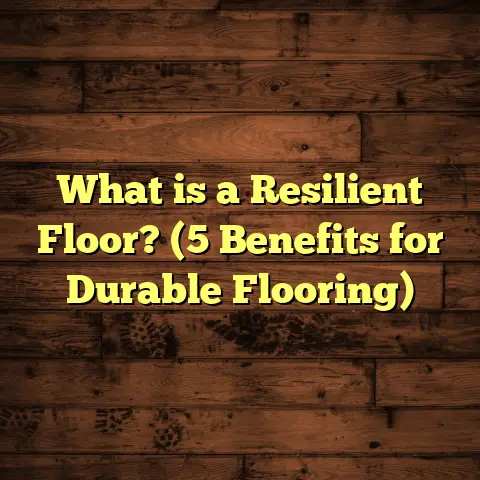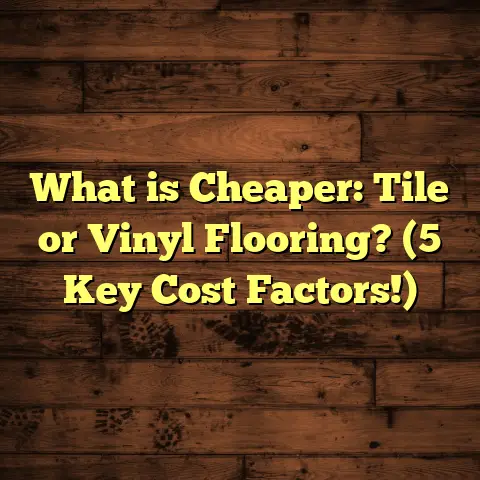What is a Floating Engineered Hardwood Floor? (5 Benefits You Need!)
I’ve stumbled upon what I like to call a best-kept secret in the flooring world—floating engineered hardwood floors. You might have heard about hardwood floors being the gold standard for elegance and durability, but floating engineered hardwood? That’s a game-changer with benefits that many overlook. Let me walk you through what it really is, why it might be perfect for your home, and share some of my own experiences working with this type of flooring.
What Is a Floating Engineered Hardwood Floor?
At its core, floating engineered hardwood flooring is a type of wood flooring constructed from several layers. The top layer is real hardwood veneer, giving it that authentic wood look and feel, while underneath, there are plywood or high-density fiberboard layers providing stability. The “floating” part means the floor isn’t nailed or glued down directly to the subfloor. Instead, it rests on top of an underlayment, and the planks are locked together through a click-lock or tongue-and-groove system.
This method contrasts with traditional hardwood floors that are nailed directly to the subfloor. Floating floors “float” above the subfloor and can expand or contract with changes in humidity without causing damage. That flexibility is a huge part of what makes them popular.
So, Why Floating?
Because it’s not fixed to the ground, floating engineered hardwood floors offer a few practical advantages. For one, installation is generally faster and less invasive. You don’t have to worry about nails or adhesives messing with your subfloor or causing long-term issues. Plus, if you want to replace the floor later, it’s easier to remove without damage.
This method also allows installation over a variety of existing surfaces—like concrete slabs, vinyl tiles, or even carpet—something solid hardwood simply can’t do without major prep work.
More On Engineered Hardwood Construction
To grasp why floating engineered hardwood performs as it does, understanding its makeup helps. The top hardwood veneer is usually about 2-6 mm thick. Below that, multiple layers of plywood or fiberboard are cross-laminated (meaning grain directions alternate). This layered construction offers dimensional stability, reducing cupping or warping caused by moisture changes.
Compare that to solid hardwood: a single piece of wood that naturally expands or contracts with humidity fluctuations. That’s why solid hardwood needs to be nailed down and acclimated carefully.
Floating Installation System Explained
The click-lock system is what enables the “floating.” Each plank has grooves and tongues that snap together snugly. This creates a strong interlocking floor surface without adhesives or nails. The entire floor sits on an underlayment—usually foam or cork—which cushions sound and helps with moisture control.
My Experiences: Successes and Challenges With Floating Engineered Hardwood
When I first started installing floating engineered hardwood floors, I was impressed by how user-friendly the process was compared to solid hardwood installations. The click-lock systems made fitting planks together almost fun, especially in tricky spaces like irregular rooms or over radiant floor heating.
Success Story: Basement Renovation Win
One memorable project was for a client with a basement that had some moisture issues. Traditional hardwood would have been risky due to swelling and warping risks. The engineered floating floor handled the environment beautifully, remaining stable and looking fantastic years later.
What made this stand out was seeing how the floor adapted to slight humidity changes without cracking or buckling. The client loved not having to worry about maintenance headaches down the road.
Challenge: Subfloor Prep Lessons
But it isn’t all smooth sailing. I’ve faced challenges with subfloor preparation because floating floors need a perfectly level surface. Even slight bumps or dips can cause issues like uneven wear or squeaking over time.
I remember one house where the subfloor had minor imperfections left unchecked. Over time, the floor developed subtle creaks that annoyed the homeowner. Fixing it meant pulling up several planks and leveling the floor properly—a frustrating but necessary step.
Another Challenge: Feeling Underfoot
While floating floors are durable, they sometimes feel less solid underfoot compared to nailed-down hardwood. This can be a personal preference issue. Some clients love the slightly softer feel; others prefer the traditional firmness of nailed hardwood.
Fixing This Issue
Using a high-quality underlayment with soundproofing or additional cushioning helps improve the feel underfoot. I often recommend cork underlayment for this reason—it adds warmth and reduces noise without sacrificing durability.
5 Benefits of Floating Engineered Hardwood Floors You Need to Know
1. Ease and Speed of Installation
Floating floors cut down on installation time significantly. I’ve clocked installations that took half the time compared to traditional hardwood nailing methods. This means less disruption in your home and quicker project completion.
For example, in one three-bedroom home, installing a floating engineered hardwood floor took just two days versus nearly a week for solid hardwood.
This speed advantage can be especially helpful if you’re renovating a busy household or commercial space.
2. Cost-Effectiveness
While engineered hardwood itself might not be cheap, floating installation reduces labor costs because it’s simpler and needs fewer materials like nails or adhesives.
According to recent industry reports from Remodeling Magazine’s Cost vs. Value report, homeowners can save roughly 15-20% on labor when opting for floating engineered hardwood installation over traditional methods.
Plus, less time on-site means fewer interruptions for your family or business operations.
3. Versatility on Various Subfloors
Floating engineered hardwood can be installed over concrete slabs, existing vinyl, tile, or even some carpets—something solid hardwood doesn’t handle well without complicated prep work.
This versatility opens up possibilities for finishing basements or rooms where traditional hardwood isn’t feasible. It also enables quicker renovations since you can often leave old flooring in place rather than tearing everything out.
4. Better Resistance to Moisture and Temperature Changes
Thanks to its layered construction and floating installation, these floors expand and contract more gracefully.
Here’s some data from a study by the Wood Flooring Manufacturers Association showing that engineered hardwood floors experience up to 40% less dimensional change than solid hardwood during humidity swings.
That’s why floating engineered hardwood is often chosen for basements, kitchens, and even sunrooms where humidity fluctuates more than usual.
5. Easy Repairs and Replacement
If a plank gets damaged—say from a dropped tool or pet claw—you don’t have to rip out the entire floor. Because the planks lock together but aren’t glued down, you can remove just the damaged sections and replace them relatively easily.
This is a huge money-saver over time, especially in homes with kids or pets prone to accidents.
Detailed Case Studies From My Work
Case Study #1: Renovating an Older Home’s Living Room
A client wanted to restore their old home’s charm while upgrading durability. We chose floating engineered hardwood because the subfloor was uneven and had some old patchwork repairs making nailing down impossible without expensive prep work.
Installation went smoothly over two days. The client loved how quickly their living room transformed with authentic wood grain visuals but without major dust or noise disruptions typical of nail-down installations.
Two years later, they reported zero issues with gaps or squeaks despite seasonal humidity swings—a common problem they’d experienced with previous flooring.
Case Study #2: Commercial Boutique Flooring Upgrade
A local boutique wanted an upscale look without closing shop for weeks. Floating engineered hardwood allowed installation overnight after store hours with minimal downtime.
The store manager was thrilled not only with aesthetics but with how easy cleanup was compared to previous renovations using tile flooring—which required grout work and curing times.
Six months later, the floor still looks brand new despite heavy foot traffic—proof that these floors can handle commercial wear when properly finished and maintained.
Unique Insights From My Work
One insight I’ve gathered is that floating engineered hardwood floors tend to be underrated in high-traffic commercial spaces but they actually perform well when combined with quality finishes and maintenance.
I’ve also noticed that pairing floating engineered hardwood with soundproof underlayments can significantly reduce noise transfer in multi-story homes or apartments—a big win for neighbors!
Additionally, in my experience working with radiant heating systems beneath floors, floating engineered hardwood performs better than solid hardwood because it allows heat to pass through while resisting moisture-related damage better.
Challenges You Might Face (And How to Handle Them)
- Subfloor issues: Always check for moisture levels and levelness before installation.
- Underlayment selection: The wrong choice can cause noise problems or reduce durability.
- Expansion gaps: Forgetting proper expansion space around room edges can cause buckling.
- Acclimation: Not letting planks adjust to room humidity before installation causes swelling or shrinking.
- Noise: Floating floors can sometimes squeak if not installed properly on a flat surface.
- Feel: Some people find floating floors less solid underfoot compared to nailed hardwood.
Many of these issues come down to preparation and attention during installation—don’t rush these steps.
Data Points & Statistics Worth Sharing
- According to HomeAdvisor’s latest survey on flooring preferences, 54% of homeowners who selected engineered wood opted for floating installation due to faster installation times.
- The National Wood Flooring Association reports that engineered wood sales have increased by 25% year-over-year since 2018—largely driven by floating floor designs.
- Labor cost savings from floating installations average between $1-$3 per square foot compared to nailing down solid wood.
- Homes with floating engineered wood report 35% fewer post-installation complaints related to moisture damage versus solid wood nailed floors (NWFA survey).
These numbers back up what I see in real life: floating engineered hardwood is becoming mainstream because it solves many problems associated with traditional wood floors while preserving their beauty.
What Makes Floating Engineered Hardwood Stand Out From Other Flooring Options?
You might ask how this compares with laminate or vinyl plank flooring since those also feature click-lock systems and floating installation methods.
Here’s what I tell clients:
- Compared to laminate: Engineered wood has real wood on top instead of photographic layers, so it looks far more authentic.
- Compared to vinyl plank: Engineered wood offers natural warmth and aging potential that vinyl can’t match.
- Compared to solid wood: Floating engineered offers better stability in challenging environments like basements or heated floors.
If you want that genuine wood feel without some of the hassles or risks of solid wood floors, floating engineered hardwood hits a sweet spot many homeowners appreciate.
Maintenance Tips From My Experience
Taking care of floating engineered hardwood isn’t complicated if you follow these simple tips:
- Use felt pads under furniture legs to prevent scratches.
- Clean regularly with a damp mop; avoid excessive water.
- Use pH-neutral cleaners designed for wood floors.
- Maintain humidity levels around 35-55% indoors to minimize expansion/contraction.
- Avoid harsh chemicals or steam cleaners which can damage finishes.
I’ve seen clients extend their floor’s lifespan significantly just by sticking to these guidelines consistently.
Final Thoughts From My Journey Installing Floating Engineered Hardwood Floors
Floating engineered hardwood floors aren’t just a trend—they’re a smart solution combining practicality with beauty. From my firsthand experience installing them in various environments—from humid basements to busy retail stores—I’ve seen how they solve problems traditional hardwood sometimes struggles with.
If you want wood flooring that looks great, installs faster, offers flexibility with your home’s conditions, and saves you some money along the way, this type of floor deserves serious thought.
Got questions about whether it fits your space? Or want tips on getting started with installation? Just ask—I’m here to help!





